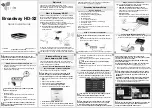
NEO-M9N - Integration manual
UBX message it can be sent directly to the receiver with no extra packaging. If required the user can
select to employ flow control, but in most cases this is likely to prove unnecessary.
When parsing the data obtained from the AssistNow Offline service the following points should be
noted:
• The data is made up of a sequence of UBX-MGA-ANO messages.
• Customers should not rely on the messages all being of fixed size, but should read their length
from the UBX header to work out where the message ends (and where the next begins).
• Each message indicates the SV for which it is applicable through the svId and gnssId fields.
• Each message contains a date-stamp within the year, month and day fields.
• Midday (UTC) on the day indicated should be considered to be the point at which the data is
most applicable.
• The messages will be ordered chronologically, earliest first.
• Messages with same date-stamp will be ordered by ascending gnssId and then ascending svId.
3.9.3.4.1 Host-based procedure
The following steps are a typical sequence for host-based AssistNow Offline:
• The host downloads a copy of the latest data from the AssistNow Offline service and stores it
locally.
• Optionally it may also download a current set of almanac data from the AssistNow Online
service.
• The host wants to use the u-blox receiver.
• If necessary it uploads any almanac, position estimate and/or time estimate to the receiver.
• It scans through AssistNow Offline data looking for entries with a date-stamp that most
closely matches the current (UTC) time/date.
• The host sends each such UBX-MGA-ANO message to the receiver.
Note that when data has been downloaded from the AssistNow Offline service with the (default)
resolution of one day, the means for selecting the closest matching date-stamp is simply to look for
ones with the current (UTC) date.
3.9.4 AssistNow Autonomous
3.9.4.1 Introduction
The assistance scenarios covered by
AssistNow Online
and
AssistNow Offline
require an online
connection and a host that can use this connection to download aiding data and provide this to the
receiver when required.
The
AssistNow Autonomous
feature provides a functionality similar to
AssistNow Offline
without the
need for a host and a connection. Based on a broadcast ephemeris downloaded from the satellite
(or obtained by
AssistNow Online
) the receiver can autonomously (i.e. without any host interaction
or online connection) generate an accurate satellite orbit representation ("AssistNow Autonomous
data") that is usable for navigation much longer than the underlying broadcast ephemeris was
intended for. This makes downloading new ephemeris or aiding data for the first fix unnecessary for
subsequent startups of the receiver.
The
AssistNow Autonomous
feature is enabled by default. It can be disabled using the CFG-
ANA-USE_ANA configuration item.
3.9.4.2 Concept
The figure below illustrates the
AssistNow Autonomous
concept in a graphical way. Note that the
figure is a qualitative illustration and is not to scale.
UBX-19014286 - R07
3 Receiver functionality
Page 37 of 95
C1-Public
















































